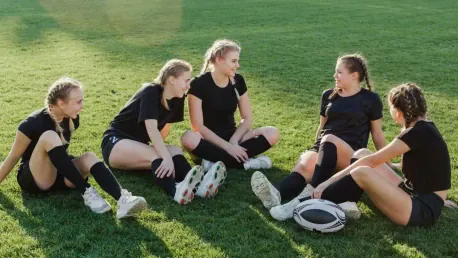The debate over whether transgender students should be allowed to participate in school sports teams that align with their gender identity has become a highly contentious issue. This discussion has garnered attention from policymakers, educators, athletes, and advocacy groups. The recent executive order by President Donald Trump, which bars transgender girls and women from participating in sports teams that match their gender identity, has further intensified the debate. This has led to widespread discussions and reactions from various sectors, reflecting the complexities and sensitivities surrounding this critical issue.
Executive Order and Its Implications
President Trump’s executive order has significant implications for educational institutions across the United States. The order mandates that schools receiving federal funding must comply with the new regulations or risk losing their funding under Title IX, the civil rights law that prohibits sex-based discrimination in federally funded educational programs. This directive has forced many K-12 schools and colleges to reevaluate their policies regarding transgender athletes. Compliance with these new regulations has become a critical concern for educational institutions striving to maintain their federal support while navigating sensitive issues of gender identity and inclusion.
The U.S. Secretary of Education has been directed to prioritize Title IX enforcement actions against institutions where women are compelled to compete with or appear unclothed before transgender individuals. This move has sparked a wave of policy changes in schools, as they seek to align with the federal mandate to avoid losing crucial funding. The directive has also generated intense debate about privacy, fairness, and the rights of transgender students, creating a complex landscape for educational administrators to navigate as they implement new policies that balance compliance and inclusivity.
Reactions from Conservative Supporters
Conservative lawmakers and groups have largely praised the executive order, viewing it as a necessary step to protect fairness in women’s sports. They argue that recognizing biological differences is essential to ensuring that female athletes have the opportunity to compete safely and fairly. Representatives such as Tim Walberg and Nancy Mace have commended the order for its focus on maintaining competitive integrity in women’s sports. This perspective underscores a broader belief that biological sex, rather than gender identity, should be the primary determinant in sports participation to safeguard equitable competition.
Supporters of the order believe that allowing transgender girls and women to compete on women’s sports teams undermines the level playing field that Title IX was designed to create. They argue that biological males have inherent physical advantages that can disadvantage female athletes, making it difficult for them to compete on an equal footing. This viewpoint emphasizes the physical disparities that can exist between biological sexes and contends that maintaining sex-segregated sports categories is crucial for preserving competitive fairness and opportunities for female athletes.
Opposition from LGBTQ+ Advocates
On the other side of the debate, LGBTQ+ advocates have strongly criticized the executive order, arguing that it unfairly targets transgender children and deprives them of the chance to engage in team sports. Human Rights Campaign President Kelley Robinson has emphasized the importance of inclusion in sports for all students, condemning the order as a partisan attempt to make life more challenging for transgender students. Advocates argue that the executive order not only discriminates against transgender students but also undermines their ability to participate fully in educational and extracurricular activities essential for their development.
Advocates contend that participation in sports is a crucial aspect of the educational experience, providing students with opportunities for physical activity, teamwork, and personal growth. They argue that excluding transgender students from sports teams that align with their gender identity perpetuates discrimination and harms their mental and emotional well-being. By denying these students equal access to sports, the order is seen as contributing to stigmatization and exclusion, which can have long-term negative effects on their psychological health and overall educational experience.
Legal and Administrative Context
The executive order follows a court decision that struck down the Biden administration’s Title IX regulations aimed at safeguarding LGBTQ+ student protections. As a result, the U.S. Department of Education will revert to July 2020 regulations, which emphasize sex-based discrimination definitions from the first Trump administration. This shift in policy has significant implications for how schools address issues of gender identity and discrimination. The legal and administrative context surrounding this executive order highlights the ongoing shifts in federal policy regarding the rights of transgender students and the complex interplay between federal and legal precedents.
The order also aligns with President Trump’s Day 1 directive, which recognizes only two sexes: male and female, based on reproductive cells. This definition has influenced federal education policy and has been a point of contention in the broader debate over transgender rights. By reinforcing a binary understanding of sex, the executive order and the associated policies challenge the more inclusive approaches adopted by previous administrations, underscoring the contentious nature of gender identity issues within educational and political arenas.
Impact on Educational Institutions
The executive order has placed educational institutions in a challenging position, as they must navigate the complex landscape of federal regulations and potential legal challenges. Schools that fail to comply with the order risk losing federal funding, which can have severe consequences for their operations and programs. This situation has compelled many schools to evaluate their policies and consider the implications of non-compliance, driving various administrative and legal responses to reconcile federal mandates with institutional commitments to equity and inclusion.
Many schools are now faced with the difficult task of balancing compliance with the executive order while also supporting the rights and well-being of their transgender students. This has led to a range of responses, with some institutions implementing new policies to align with the federal mandate, while others seek to challenge the order through legal means. The diverse approaches taken by schools reflect the broader societal debate over transgender rights, illustrating the complex decisions that educational leaders must make in striving to honor both legal obligations and moral commitments to their students’ welfare.
Broader Societal Implications
The debate over transgender participation in school sports reflects broader societal discussions about gender identity, equality, and inclusion. It highlights the ongoing struggle to balance competing values and interests in a way that respects the rights and dignity of all individuals. These discussions resonate beyond the realm of sports, touching on fundamental questions about how society defines and respects gender, the role of legal and policy frameworks in safeguarding rights, and the evolving understanding of inclusion and fairness in educational and social contexts.
As the legal and political landscape continues to evolve, the issue of transgender students in school sports remains a focal point of contention. The executive order has brought the debate to the forefront, prompting a reevaluation of policies and practices at both the state and federal levels. The controversy underscores the ever-present tension between tradition and progress, with policymakers, educators, and advocates striving to find equitable solutions that honor the diverse experiences and identities of all students.
Statistical Context and Trends
Transgender students constitute a small fraction of the school sports population. Data indicates that fewer than 10 transgender athletes compete in college sports, and only 1.4% of children aged 13 to 17 identify as transgender. Among them, a minority participate in school sports. Despite their small numbers, the presence of transgender athletes has sparked significant debate and policy changes. The statistical context provides critical insights into the scale of the issue while highlighting the disproportionate impact and scrutiny faced by transgender athletes in school sports settings.
Several conservative-led states have enacted laws limiting transgender students’ participation in sports, mirroring the intent of Trump’s executive order at the state level. At the federal level, the House has passed a bill prohibiting transgender women from competing on women’s sports teams, though it awaits a Senate vote. These legislative trends reflect the broader societal divide on transgender rights, reinforcing the complexities and contentious nature of the debate. The evolving legal landscape continues to shape the experiences of transgender students, with ongoing implications for educational policies and practices.
The Path Forward
The debate over transgender students participating in school sports teams that align with their gender identity has become intensely polarizing. This issue has attracted significant attention from policymakers, educators, athletes, and advocacy groups. A recent executive order by President Donald Trump, which restricts transgender girls and women from joining sports teams consistent with their gender identity, has added fuel to the fire. This order has sparked widespread conversations and reactions across various sectors, reflecting the intricate and sensitive nature of this important topic. Supporters argue that it preserves fair competition, while opponents contend it discriminates against transgender individuals, harming their mental health and social inclusion. The discussions highlight not only legislative complexities but also broader societal concerns about equality and rights, underscoring the need for thoughtful dialogue and informed decisions on how to balance fairness with inclusion in school sports environments.









